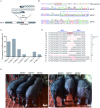Targeted mutations in myostatin by zinc-finger nucleases result in double-muscled phenotype in Meishan pigs
- PMID: 26400270
- PMCID: PMC4585837
- DOI: 10.1038/srep14435
Targeted mutations in myostatin by zinc-finger nucleases result in double-muscled phenotype in Meishan pigs
Abstract
Myostatin (MSTN) is a dominant inhibitor of skeletal muscle development and growth. Mutations in MSTN gene can lead to muscle hypertrophy or double-muscled (DM) phenotype in cattle, sheep, dog and human. However, there has not been reported significant muscle phenotypes in pigs in association with MSTN mutations. Pigs are an important source of meat production, as well as serve as a preferred animal model for the studies of human disease. To study the impacts of MSTN mutations on skeletal muscle growth in pigs, we generated MSTN-mutant Meishan pigs with no marker gene via zinc finger nucleases (ZFN) technology. The MSTN-mutant pigs developed and grew normally, had increased muscle mass with decreased fat accumulation compared with wild type pigs, and homozygote MSTN mutant (MSTN(-/-)) pigs had apparent DM phenotype, and individual muscle mass increased by 100% over their wild-type controls (MSTN(+/+)) at eight months of age as a result of myofiber hyperplasia. Interestingly, 20% MSTN-mutant pigs had one extra thoracic vertebra. The MSTN-mutant pigs will not only offer a way of fast genetic improvement of lean meat for local fat-type indigenous pig breeds, but also serve as an important large animal model for biomedical studies of musculoskeletal formation, development and diseases.
Figures





References
-
- Grobet L. et al. A deletion in the bovine myostatin gene causes the double-muscled phenotype in cattle. Nat Genet 17, 71–74 (1997). - PubMed
-
- Zimmers T. A. et al. Induction of cachexia in mice by systemically administered myostatin. Science 296, 1486–1488 (2002). - PubMed
-
- Hill J. J., Qiu Y., Hewick R. M. & Wolfman N. M. Regulation of myostatin in vivo by growth and differentiation factor-associated serum protein-1: a novel protein with protease inhibitor and follistatin domains. Mol Endocrinol 17, 1144–1154 (2003). - PubMed
Publication types
MeSH terms
Substances
LinkOut - more resources
Full Text Sources
Other Literature Sources
Molecular Biology Databases
Miscellaneous

